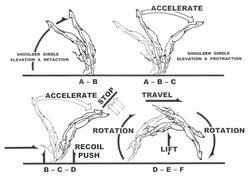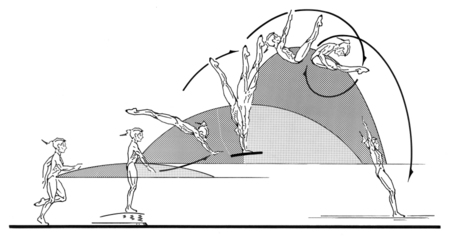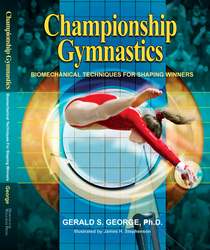|

___________________________________________________________
|
|
|
|
|
|

Concepts of Uneven Bars*
by Gerald S. George, Ph.D.
|
The farther away you get,
the closer you are to home...
The women's Uneven Bars event is similar to the men's Horizontal Bar event, as both are entirely swing-oriented and involve essentially the same types of skills. However, the Uneven Bars is clearly more the complex and challenging event, because it requires the gymnast to interface about two rails of differing heights. In addition, the larger-diameter rails make these intricate release/regrasp moves somewhat more difficult, particularly in light of the hand-size difference between the typical male and female gymnast. Because the performer must blend elite-level swing skills back and forth about these rails, many consider the Uneven Bars the most exciting event in all of artistic gymnastics!
|
|
|
|
|
DANCING WITH THE BARS
|
Because the rails of the uneven bars are "elastic" in nature, they not only bend (deflect) according to the amount and direction of the forces applied but also return quickly (restitute) to their original shape once these forces terminate. This bending or "loading action" in the bar serves to momentarily store energy that can--and should--be employed for the very next phase of the movement. And as discussed, it is the body's internal-swing movements that largely determine the direction and degree of deflection/restitution in the bar rail. This elastic property is not only critical to optimum execution of all giant swing skills but can also facilitate on-bar "cast-oriented" skills.
For example, the Cast to Handstand in figure 12.1 illustrates precisely "how" the bar responds when a proper "cast-action" is applied. The performer starts in a loaded or piked front-support position with the body's upper and lower halves tightly wrapped about the bar (illustration A). Notice that the shoulder girdle is fully elevated and remains so through the entire skill. A forceful, vigorous hip-joint extension not only drives the legs and feet in a back-upward direction but also simultaneously presses the pelvic girdle against--and therefore loads--the bar in a fore-downward direction (B). The depressed bar (deflection) indicates energy has been momentarily stored for immediate use in the upcoming rise to the handstand.  Figure 12.1. The bar rail's response to an effective cast-action in executing a Cast to Handstand on the uneven bars.
Just prior to attaining a straight-line body shape, the forceful leg drive is "instantaneously stopped," causing its momentum to be transferred into the total body (C). As this leg momentum is being transferred, the momentarily loaded bar quickly "fires back" to its original position (restitution), adding a further lifting impetus to an already-rising body (C, D). It is important to reiterate the sequence of events: 1) the forceful leg drive causes the pelvic girdle to push against, and thereby load, the bar in a fore-downward direction; 2) the instantaneous stopping action of the leg-drive causes the legs' momentum to transfer into the total body unit in a back-upward direction; 3) the "loaded" bar rail returns to its original position just as the momentum transfer of the legs into the total body unit is being completed; and 4) the "unloading" of the bar provides an additional lifting impetus to the cast-action. From a timing standpoint, it is critical that the performer be able to "feel" the subtle performance characteristics in the elastic bar. For example, the actual push- action of the hands against the bar should occur just as the deflected bar "unloads" its stored energy. Once this push-action begins, notice how the performer literally "unfolds" in a progressive sequential fashion, up into the handstand position (E, F, G, H). Precise "timing" is perhaps the most critical component in the "dance" of gymnastics.
~~~~~~~~~~~~~~~~~~~~~~~~~~~~~~~~~~~~~~~~~~~~~~~~~~~~~~~~~~~~~~~~~~~~~~~~~~
*This article excerpted from Championship Gymnastics: Biomechanical Techniques for Shaping Winners. For additional information, see Chapter 12, "Concepts of Uneven Bars," pages 249-266. Also covered are:
- Swinging-A Closed-Loop System of Kinesthetic Awareness
- The Elastic-Ruler Concept
- Keeping the Giant in the Swing
- The Circumduction Technique
- The Handstand Arrival-A Litmus Test for Excellence
- Timing the Release
- Tapping the Release
- The Bottoming Effect
- The Slingshot Technique
|
|
Save $10 Now!
|
Save $10.00 now on your order of Championship Gymnastics! Just use promo code: GYMCOACH when ordering online, or by phone. This is a limited time offer, so place your order now to get this one-time savings!
| |
|
"Championship Gymnastics" -- Featuring 140 Gymnastic Illustrations
Currently Used In 44 Countries Worldwide! |   140 Illustrations Show You the Exact Positions and Movements for Achieving Success and Shaping Championship Winners. 140 Illustrations Show You the Exact Positions and Movements for Achieving Success and Shaping Championship Winners.
Rather than laboring on complex physics formulas, fundamental principles of biomechanics are clearly explained and presented in layman's terms.
Easy to read and expertly illustrated, readers are guided effortlessly through a "conceptualization process" for developing ideal movement patterns. The book includes 140 technical illustrations by noted artist and gymnastics coach Jim Stephenson.
|
Get the Tools and Learn the Techniques You Need
to Become a Championship Winner!
- Learn Time-Tested Principles for Shaping Winners
- 140 Illustrations Show You the Exact Positions and Movements for Achieving Success and Shaping Championship Winners
- Understand the Biomechanical Principles Underlying All Gymnastics Skills
- Learn the Fundamental Concepts of Proper Training for Power and Flexibility
- Apply an Easy-to-Follow System for the Fundamental Patterns of Gymnastics Movement
- Discover Ten Key Teaching Concepts for Success in Each of the Four Olympic Gymnastics Events for Women
Take this opportunity to be among the first to receive the valuable information contained in this book, and start or continue your journey to achieve success in winning gymnastics championships!
|
|
|
|
|
|
|